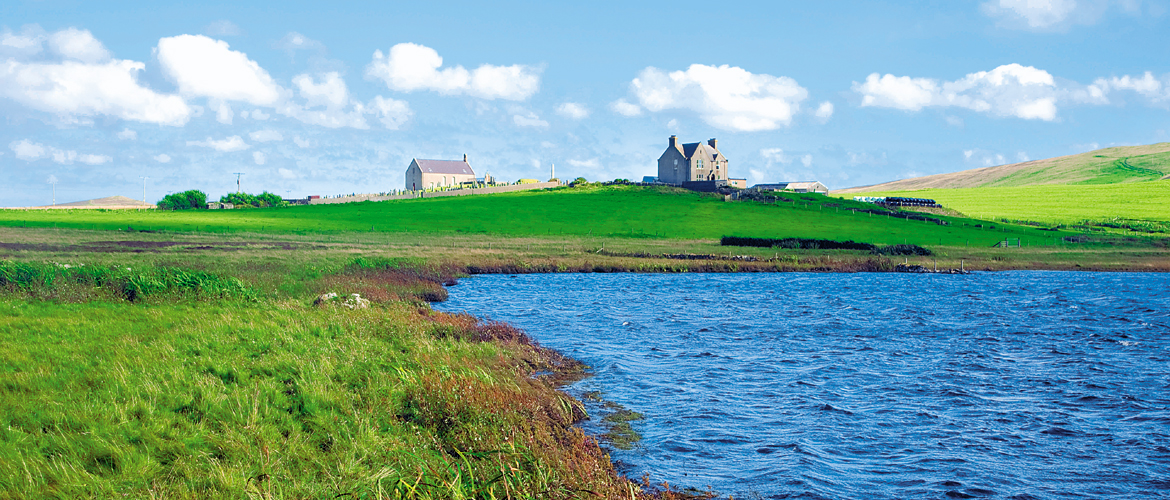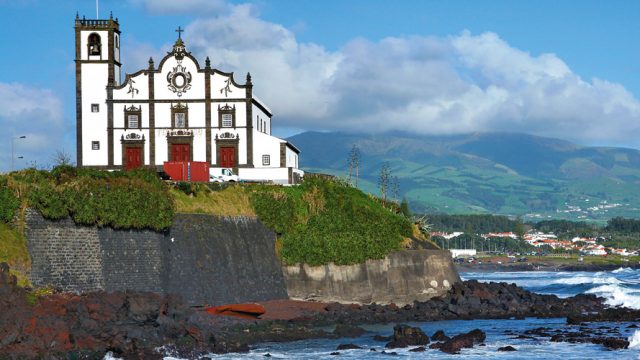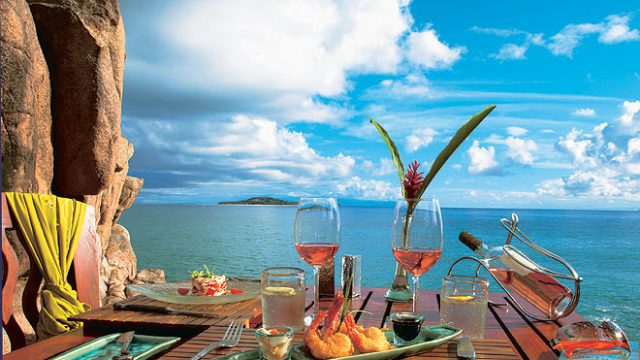After 35 minutes of being tossed around by high-velocity winds since leaving Aberdeen, the Fairchild 340 touches
The next morning is wet and windy. Thanks to Dave Lawrence, the archaeologist who will be my guide, I’m prepared. Our first stop is Mine Howe, an Iron Age underground chamber on a farm. The site is not open to tourists, but Dave has obtained the farm owner’s permission to visit it. He hands me a helmet and a torch as we walk towards the low mound within which the chamber is hidden. A massive ditch and bank—the henge—encircles the mound, only partly excavated. Clearly, not many were allowed here even 2,000 years ago.
As I peer down into the manhole-sized shaft that leads into the depths, my excitement mounts. Mine Howe is arguably one of the most mysterious structures in the world. Dave warns me that breathing might be difficult once we descend into the chamber—the wind blowing over the shaft’s mouth prevents effective circulation inside.
After warning me about the irregularly shaped steps, Dave begins his descent. A modern-day iron ladder bridges the gap between the opening and the first step of the stone stairway. I climb down slowly and with trepidation, holding on to the iron rail fastened to the wall. The stone stairs are tricky and the shaft is narrow. I reach a small landing, illuminated by Dave’s torch. Down a second flight of stairs and another iron frame bridging the three-foot gap between the final stone stair and the floor of the chamber, and I find myself in a vertical, irregular cylinder made of dry rock piled up underground, almost four feet in diameter and 12 feet in height. Our breath comes in gasps—Dave wasn’t joking about the air quality. Our torches are off, plunging the chamber into an inky darkness. More terrifying than the darkness is the silence—it is absolute and oppressive. Whoever built this chamber ensured that no light or sound would penetrate it. I take photographs with some difficulty, since there is little room to manoeuvre; and then it’s time to leave. Dave points out two smaller chambers built into the wall above the main chamber. My mind is abuzz—why was this structure built? What purpose could it have served?
Next, we visit the Rennibister Earth House, another interesting underground structure, but it is the so-called burial mounds that I am really interested in.
Dave hands me a pair of gloves and knee pads as we arrive at the first of these—the Cuween Hill Chambered Cairn—so called because of the four small cells that lead off the main chamber. The entrance to the cairn is halfway up a hill, through a passageway around three feet high. I realise what the knee pads are for as we crawl through the entrance to gain access to the main chamber. Within, I am overawed by the masonry—the dry stone walls built without use of mortar. I am able to crawl into three of the side chambers through openings which are two-and-a-half feet high.
Dave tells me that the roofs of all the cairns were destroyed around 2500 BCE. Few human remains were found in these cairns—unusual for community burial chambers; most of the bones have disappeared. Maes Howe is our next stop—a 5,000-year-old mound with an enormous central chamber with four cornerstones that weigh 70 tonnes each and three side chambers. It is renowned for its alignment with the rising sun, which shines onto a stone placed at the far end of the chamber, opposite the entrance, at sunset on the winter solstice. No human remains were ever found here.

After visiting Unstan, another cairn, we arrive at Skara Brae: a mysterious underground stone village built 6,000 years ago, which was discovered when a storm in 1850 ripped off the turf that had concealed the settlement. I marvel at the stone constructions—a central hearth, stone beds, stone cupboards and even stone tanks to store water. Mysterious symbols are carved into the walls of the apartments. Artefacts that seem impossible to create using the primitive technology of the Stone Age have been discovered here. Their difficult angles and perfect finish rival machine-made stone artefacts of modern times. The mystery that shrouds Skara Brae revolves around why a settlement was built in a location where both food and fuel would need to be imported from elsewhere. No one seems to have an answer.

The day is rounded off with visits to two nearby stone circles—the Ring of Brodgar and the Standing Stones of Stenness.
Much to our joy, the next day dawns bright and sunny and the ferry ride to Rousay, on a cobalt blue sea, is breathtaking. My main objective is to visit Mid Howe, a huge stalled cairn on Rousay. En route, I take in the beauty of Orkney, accentuated by the azure sky and brilliant weather.

We arrive at Mid Howe where the ruins of a Stone Age Broch (tower) stand next to a building that looks like an aircraft hangar. The ruins of Mid Howe lie within this building. We trek down the hillside, crossing three levels of terraces. Nothing I have read prepares me for the sight that greets my eyes. Hundred feet long, built of stacked drystone, the cairn is divided into 24 stalls or compartments. A modern ramp and suspended bridge above the cairn enable visitors to gaze at its magnificence without entering the structure. Bones of 25 individuals have been recovered from this cairn, assumed to have been a communal tomb. Today, the roof is missing and the cairn is in ruins but I can picture the grandeur of the original structure.

We head for the remaining cairns on Rousay, all of which have stalls. The Knowe of Yarso and Blackhammer have only part of the structure still standing; both are protected within a concrete structure, but neither can match the magnificence of Mid Howe. Our final stop is Taversoe Tuick—the only two-storeyed cairn that I have read about. I head back to Tingwall, on the Mainland, the sights of Orkney occupying my mind. Who were the people who built these structures 5,000 years ago, before even the pyramids at Giza? The engineering and the design, especially the astronomical alignments, point to an advanced civilisation. I am up at the crack of dawn the next day, to catch my return flight. As I drive to the airport, I know that although my sojourn in Orkney has come to an end, part of me will always remain here.
(Christopher C. Doyle’s latest book is The Secret of the Druids)
The Information
Getting There
The archipelago of Orkney lies north of Scotland. The largest island, known as the Mainland, has an airport at Kirkwall that connects the islands to the rest of Scotland. Ferry services run between the 70 islands of the archipelago, not all of which are inhabited. It is good to go prepared with waterproof and windproof clothing and sturdy boots, since Orkney is windswept and wet nearly the entire year.
Where To Stay
You could stay at the Smithfield Hotel, in Dounby, west mainland of Orkney. The hotel is surrounded by many archaeological sites, RSPB reserves and lochs brimming with brown trout. A 15-minute drive from Kirkwall & Stromness, it has a restaurant and a public bar. (Bed and Breakfast is from £42.00 per person per night; smithfieldhotel.co.uk)
I stayed at the Ayre Hotel at Kirkwall. It features great views of the harbour, fantastic food and excellent service. (From £115 per night; ayrehotel.co.uk) There’s also Merkister Hotel by the Harray Loch. Here, breakfast is accompanied by sights of swans and herons. (From approximately ₹11,326. See merkister.com.)
What To See
The successors of the first inhabitants of these islands from the Neolithic Age, who started the agricultural tradition that still continues, built prominent sites here—stone circles, burial mounds and stone settlements—which are well preserved.
There are various historic sites to explore. The mysterious underground stone village, Skara Brae, is a must-visit. Also, notice the stone artefacts obtained from this site. Maes howe, Ring of Brodgar, Standing Stones of Stenness, Brough of Gurness, Brough of Birsay, Mid Howe are other enchanting options for first-time visitors to Orkney.
Christopher C Doyle
heritage
International




